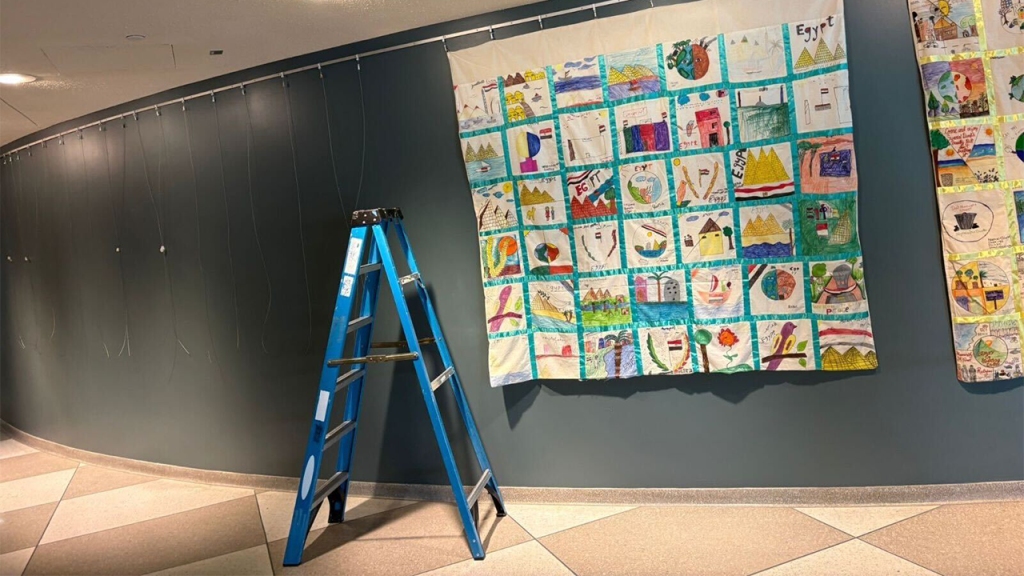The United Nations recently removed a controversial quilt panel artwork that called for the extermination of Israel following backlash from Israel’s permanent representative to the U.N., Danny Danon. The artwork featured a map of Israel resembling a watermelon without the West Bank or Gaza partition, with the Palestinian flag in the top right corner. The phrases “From the River to the Sea” and “Will be Free” on the map were interpreted differently by Israelis and Palestinians, with the former viewing it as a call to genocide and the latter as a rallying cry for freedom. The U.N. originally claimed the artwork was part of an exhibit called “Peace Flags” aimed at repurposing fashion waste for a positive impact, but later covered and then removed the controversial panel after complaints.
The phrase “From the River to the Sea, Palestine Will be Free” has become a symbolic slogan for Palestinians protesting Israel amid the ongoing conflict in Gaza, triggered by Hamas’ massacre in Israel. Israelis see the phrase as a call for the eradication of Israel, leading to condemnation of the art panel by Israel’s U.N. ambassador as a “disgrace.” The U.N. initially covered the panel after acknowledging that it should not have been displayed, but it was repeatedly uncovered. The lack of leadership in addressing the controversial artwork was criticized by Danon, who accused the U.N. of allowing antisemitism and hypocrisy. The panel was eventually removed entirely in response to the backlash and the U.N. assured that the issue was being addressed directly with the Israeli ambassador.
The incident involving the controversial quilt panel artwork highlights the deep-rooted tensions and differing interpretations of phrases and symbols in the Israeli-Palestinian conflict. The U.N.’s handling of the situation, from allowing the display of the offensive panel to eventually removing it after repeated calls for its removal, underscores the complexities of addressing sensitive issues in a global organization. The conflicting perceptions of the artwork reflect the ongoing struggle for peace and understanding in the Middle East, where historical grievances and political aspirations continue to fuel animosities and misunderstandings.
The removal of the art panel comes amidst escalating tensions in the region, with Hamas calling on President-elect Trump to intervene and stop the war in Gaza. The aftermath of the recent conflict sparked by Hamas’ actions in Israel further complicates the efforts for peace and reconciliation between Israelis and Palestinians. The incident involving the U.N. art exhibit serves as a reminder of the challenges in finding common ground and creating a peaceful resolution to the long-standing conflict, as both sides hold deeply ingrained beliefs and grievances that often lead to misinterpretations and disagreements.
The U.N.’s response to the controversy surrounding the offensive artwork demonstrates the delicate balance between promoting freedom of expression and preventing the spread of hate speech and incitement. The removal of the panel after initially defending it as part of a fashion waste repurposing initiative shows the importance of considering the implications and interpretations of art in a global context. The U.N.’s commitment to dialogue and understanding, as reflected in the removal of the controversial panel and subsequent communication with the Israeli ambassador, highlights the organization’s efforts to address sensitive issues and promote mutual respect and tolerance among nations and peoples.
In conclusion, the removal of the controversial quilt panel artwork by the U.N. underscores the complexities and challenges of addressing issues related to the Israeli-Palestinian conflict. The differing interpretations of symbols and phrases, as well as the deep-rooted historical grievances and political aspirations of both Israelis and Palestinians, continue to hinder progress towards peace and reconciliation in the region. The incident serves as a reminder of the importance of dialogue, understanding, and mutual respect in resolving conflicts and promoting a peaceful coexistence among diverse communities.


